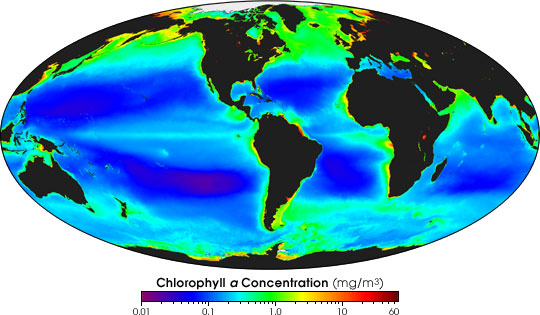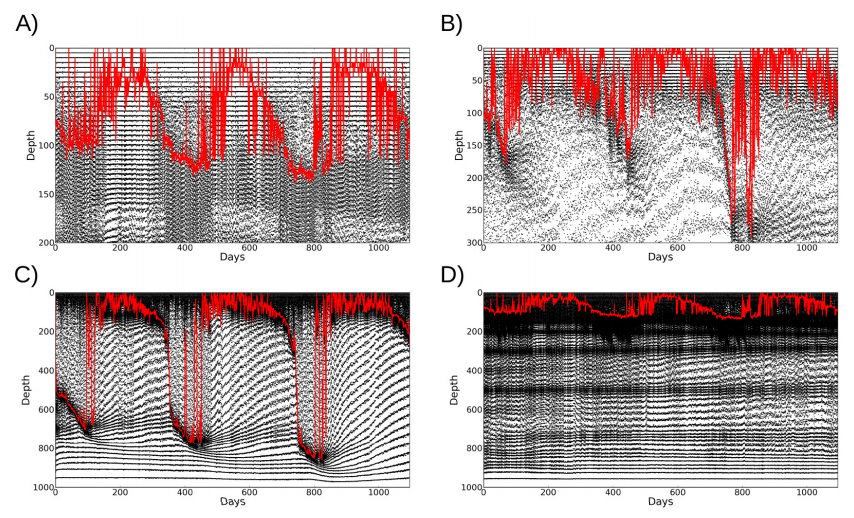The latest Geosciences Column is brought to you by Nikita Marwaha, who explains how a new generation of marine models is letting scientists open up the oceans. The new technique, described in Ocean Science, reveals what’s happening to ocean chemistry and biology at scales that are often hard to model…
Diving into the depths of the ocean without getting your feet wet is possible through biogeochemical modelling – a method used by scientists in order to study the ocean’s living systems. These simulated oceans are a means of understanding the role of underwater habitats and how they evolve over time. Covering nutrients, chlorophyll concentrations, marine plants, acidification, sea-ice coverage and flows, such modelling is an important tool used to explore the diverse field of marine biogeochemistry.
There is one outstanding problem with this technique though, as the very-small scale or
sub-mesoscale marine processes are not well represented in global ocean models. Sub-mesoscale interactions take place on a scale so small, that computational models are unable to resolve them. Short for sub-medium (or ‘sub- meso’) length flows – the smaller flows in question are on the scale of 1-10 km. They are difficult to measure and observe, but their effects are seen in satellite imagery as they twist and turn beautiful blooms of marine algae.
Sub-mesoscale phenomena play a significant role in vertical nutrient supply – the vertical transfer of nutrients from nutrient-rich deep waters to light-rich surface waters where plankton photosynthesise. This is a major area of interest since the growth of marine plants is limited by this ‘two-layered ocean’ dilemma. But the ocean is partially able to overcome this, which is where sub-mesoscale flows come in. Sub-mesoscale flows are important in regions with large temperature differences over short distances – when colder, heavier water flows beneath warmer, lighter water. This movement brings nutrient-rich water up to the light-rich surface. Therefore, accurately modelling these important small-scale processes is vital to studying their effect on ocean life.

Global chlorophyll concentration: red and green areas indicate a high level or growth, whereas blue areas have much less phytoplankton. (Credit:
SeaWiFS Project)
A group of scientists, led by Imperial College’s Jon Hill, probes the technique of biogeochemical ocean modelling and the issue of studying sub-mesoscale processes in a paper
recently published in the EGU journal Ocean Science. Rather than simply increasing the resolution of the models, the team suggests a novel method – utilising recent advances in adaptive mesh computational techniques. This simulates ocean biogeochemical behavior on a vertically adaptive computational mesh – a method of numerically analysing complex processes using a computer simulation.
What makes it adaptive? The mesh changes in response to the biogeochemical and physical state of the system throughout the simulation.
Their model is able to reproduce the general physical and biological behavior seen at three ocean stations (India, Papa and Bermuda), but two case studies really showcase this method’s potential: observing the dynamics of chlorophyll at Bermuda and assessing the sinking detritus at Papa. The team changed the adaptivity metric used to determine the varying mesh sizes and in both instances. The technique suitably determined the mesh sizes required to calculate these sub-mesoscale processes. This suggests that the use of adaptive mesh technology may offer future utility as a technique for simulating seasonal or transient biogeochemical behavior at high vertical resolution – whilst minimising the number of elements in the mesh. Further work will enable this to become a fully 3D simulation.

Comparison of different meshes produced by adaptive simulations: (a) Bermuda, taking the amount of chlorophyll into account (b) the original adaptive simulation at Bermuda, without taking chlorophyll into account (c) adaptive simulation at Papa, taking the amount of detritus into account (d) the original Papa simulation, without taking detritus into account. (Credit:
Hill et al., 2014)
The fruits of this adaptive way of studying the small-scale ocean are already emerging as the secrets of the mysterious, sub-mesoscale ocean processes are probed. The ocean holds answers to questions about our planet, its future and the role of this complex, underwater world in the bigger, ecological picture – adapting to life and how we model it may just be the key we’ve been looking for.
By Nikita Marwaha
Reference:
Hill, J., Popova, E. E., Ham, D. A., Piggott, M. D. and Srokosz, M.:
Adapting to life: ocean biogeochemical modelling and adaptive remeshing. Ocean Sci., 10, 323- 343, 2014




















